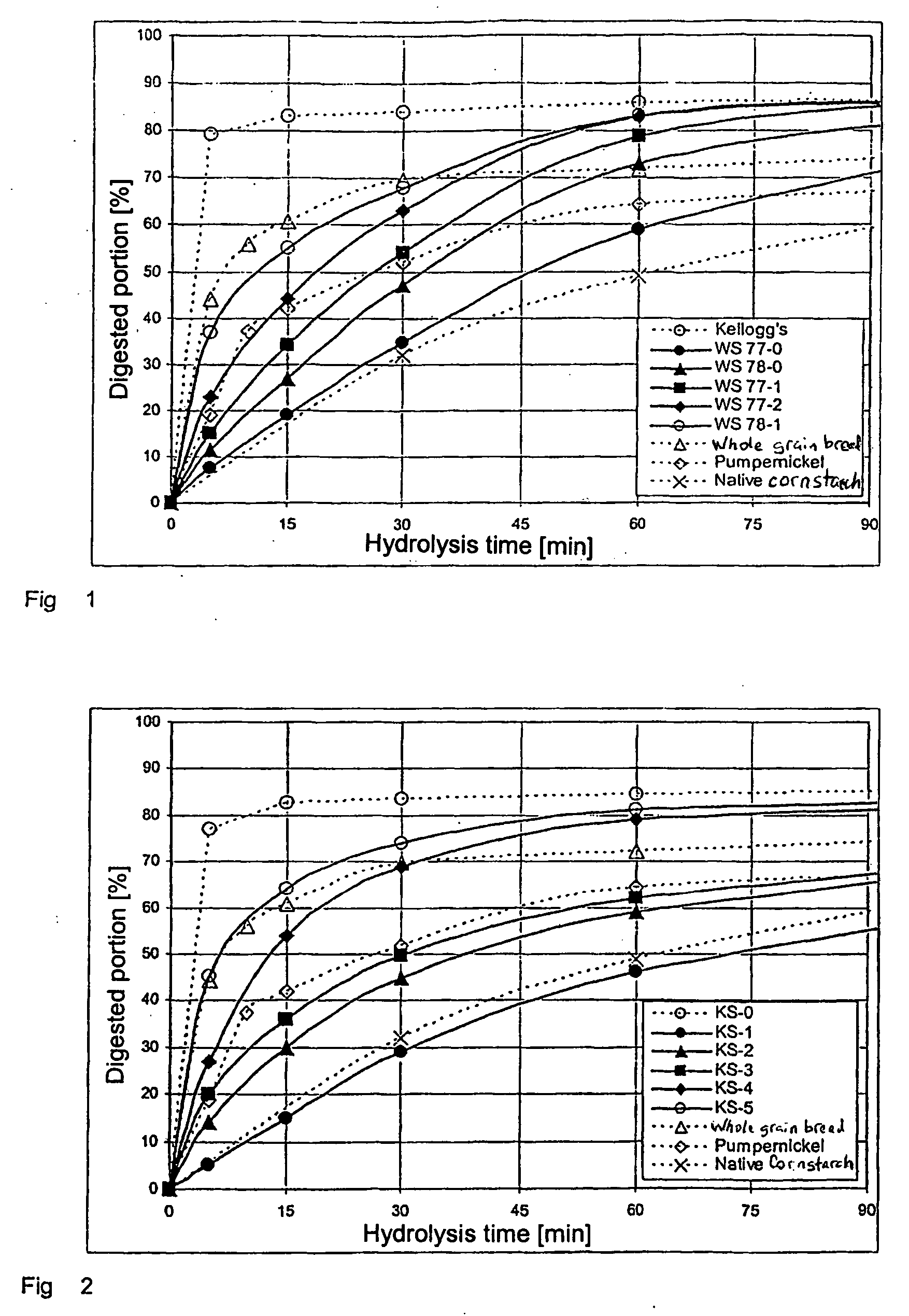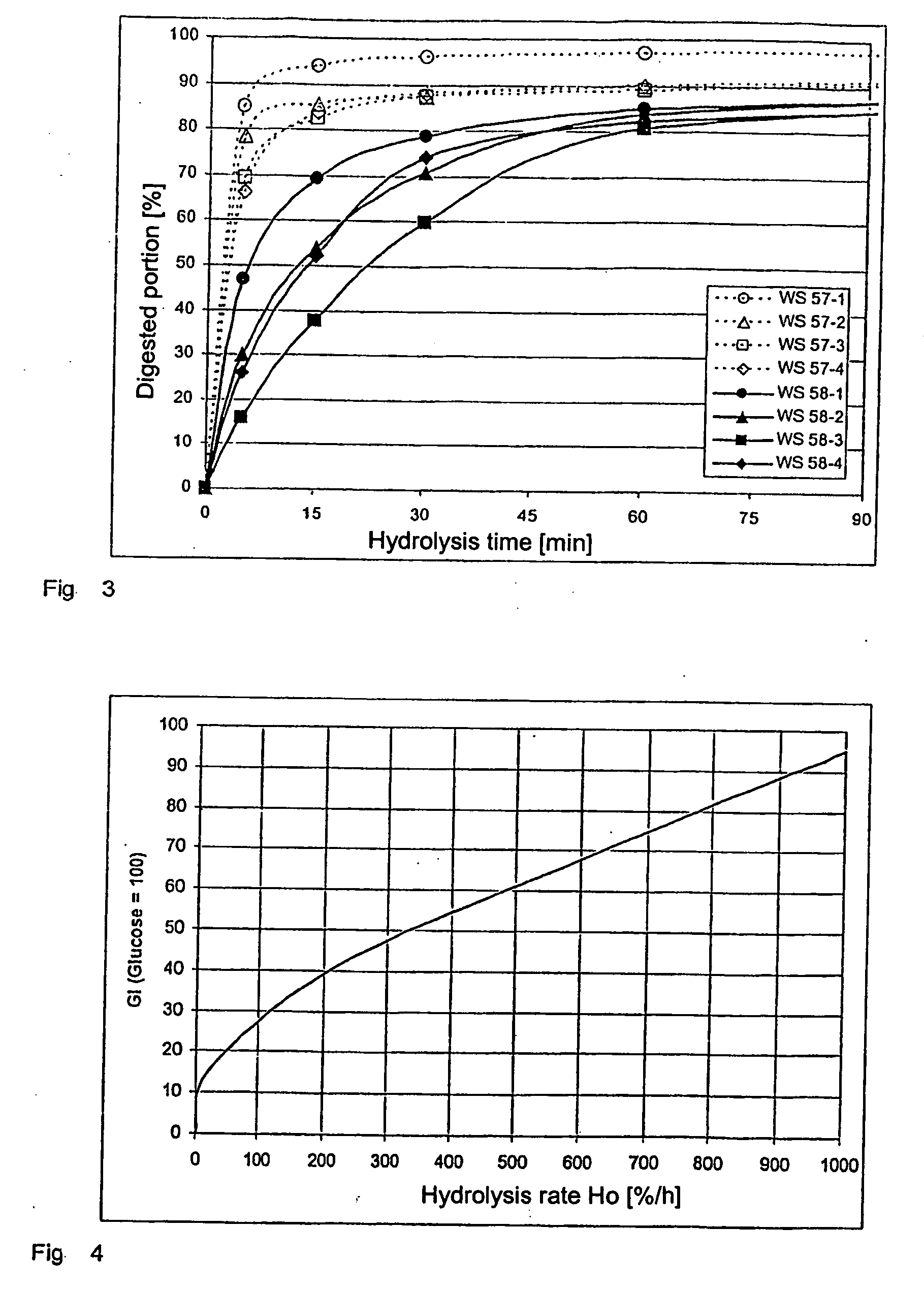Slowly digestible starch-containing foodstuffs
a technology of starch and slow digestion, which is applied in the field of slow digestion starch-containing foodstuffs, can solve the problems of limiting the entry of hydrolyzing amylases during digestion, rapid hydrolysis, and massive reduction of digestion rate, and achieves the effects of slow digestion, improved organoleptic properties, and reduced gi
- Summary
- Abstract
- Description
- Claims
- Application Information
AI Technical Summary
Benefits of technology
Problems solved by technology
Method used
Image
Examples
example 1
[0043] This example for the production of slowly digestible Corn Flakes is intended to illustrate the use of in situ technology for the pellet-to-flakes extrusion-cooking (PFEC) process. The recipes WS 77-0 to WS 77-2, WS 78-0 and WS 78-1 (compare Table 2) consisting of 91 % corn flour, 7.4% sugar, 1.4% salt and 0.2% malt in a dry state were plasticized at a water content of 31 %, a speed of 110 RPM and mass temperature of up to 105° C. for 6-8 min in a Brabender kneader with a 50 ml kneading chamber. In SCA-containing recipes in which a portion of the corn meal was replaced by SCA, the SCA was added in a spray-dried state. The homogenized kneading mass was pressed into films 0.25 mm thick in a press. These films with water contents Wo were conditioned according to the data in Table 2 by being wrapped in saran wrap and stored for 30 min at 75 to 85° C. The films were then cut into flakes, which were puffed and toasted as necessary (10% water content, 240° C., 45 s). FIG. 1 shows the...
example 2
[0044] This example for the production of slowly digestible potato snacks is intended to illustrate the use of in situ technology for the direct-expansion extrusion-cooking (DEEC) process. A recipe in the dry state consisting of 30% potato flour, 69% potato granules and 1 % salt, wherein a portion of the flour was replaced by SAC depending on the recipe, was extruded in a cooking extruder with an L / D=14 at a water content of 24% and an energy supply of 450 kJ / kg, and the 3 mm extrudate head was granulated and expanded at 150° C., wherein a water content of 13% was obtained. The Wo was then increased to the values specified in Table 2 with a moist atmosphere, and conditioned using the specified parameters. FIG. 2 shows the hydrolysis curves for the obtained expanded potato snack products. The KS-0 curve of a recipe without the use of SCA shows the hydrolysis behavior of the puffed state without ensuing conditioning. At an Ho=850% / h, the product KS-0 can therefore be digested exceedin...
example 3
[0045]FIG. 3 shows the advantageous use of short-chain amylose (SCA). A process similar to the one described in Example 1 was carried out, but only cornstarch, water and, if necessary, a portion of SCA according to the data in Table 2 were added in the form of an aqueous solution. 0.5 mm films were pressed from the plasticized mass. The corresponding conditioning processes were conducted at the values for Wo given on Table 2 by holding the water content in the samples constant via packaging with saran wrap. At a percentage of 10% SCA, significant reductions in Ho were obtained for the products WS 58-1 to WS 58-4 under suitable conditioning conditions, and even without specific conditioning (WS 58-1), while the effect of comparable conditioning processes (adjusted to the somewhat higher water content Wo) is distinctly lower for the analogous products WS 57-1 to WS 57-4. Longer times tk are necessary for achieving greater reductions in Ho for products WS 57.
PUM
| Property | Measurement | Unit |
|---|---|---|
| Temperature | aaaaa | aaaaa |
| Fraction | aaaaa | aaaaa |
| Fraction | aaaaa | aaaaa |
Abstract
Description
Claims
Application Information
 Login to View More
Login to View More - R&D
- Intellectual Property
- Life Sciences
- Materials
- Tech Scout
- Unparalleled Data Quality
- Higher Quality Content
- 60% Fewer Hallucinations
Browse by: Latest US Patents, China's latest patents, Technical Efficacy Thesaurus, Application Domain, Technology Topic, Popular Technical Reports.
© 2025 PatSnap. All rights reserved.Legal|Privacy policy|Modern Slavery Act Transparency Statement|Sitemap|About US| Contact US: help@patsnap.com


